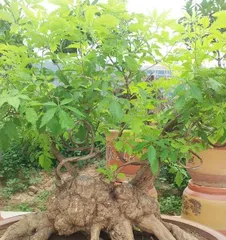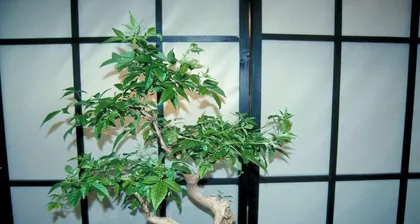Vitex negundo bonsai is a common bonsai plant, known for its beautiful tree shape and is often used for decoration. However, to make a Vitex negundo bonsai more attractive, it requires not only daily care but also regular pruning. When is the best time to prune a Vitex negundo bonsai? Which parts need to be pruned? Let's learn about it together.

I. Why Pruning is Necessary
The tree shape of a Vitex negundo bonsai is quite beautiful, but if it grows too vigorously, the crown can become dense, affecting the overall ornamental effect. Timely pruning can maintain the plant's aesthetic shape and prevent excessive density from leading to poor ventilation and waterlogging.
II. When to Prune Vitex Negundo Bonsai
Pruning for Vitex negundo bonsai is usually done in spring and autumn. Spring pruning focuses on shaping, while autumn pruning focuses on controlling growth. The specific time can be chosen between February-March and September-October each year.

III. Pruning Methods for Vitex Negundo Bonsai
1. Shaping: This mainly involves pruning the crown to remove overly dense or unattractive parts to achieve a beautiful appearance.
2. Controlling Growth: This type of pruning usually involves cutting some new shoots in spring to slow down the growth rate.
IV. Which Parts of the Vitex Negundo Bonsai Need Pruning
1. Withered Leaves: If there are withered leaves on the plant, they should be promptly removed to maintain the plant's health.

2. Water Sprouts: If the crown of the Vitex negundo bonsai is too dense, it will produce many water sprouts. These water sprouts will compete for nutrients, affecting the plant's growth. They need to be regularly pruned off.
3. Lateral Branches: Vitex negundo bonsai has many lateral branches that need regular pruning to ensure the overall tree shape is aesthetically pleasing.
4. Crossing Branches: If crossing branches appear on the plant, they will affect the overall ornamental effect and should be promptly pruned.
V. Precautions for Pruning Vitex Negundo Bonsai
1. Choose the Right Tools: Pruning tools generally include scissors and pruning saws; choose different tools for different parts.
2. Pay Attention to Hygiene: Disinfect the tools before pruning to avoid spreading diseases.
3. Do Not Over-prune: Over-pruning can adversely affect the plant, so it's important to be moderate.
4. Clean Up Pruning Debris Promptly: Pruning debris can affect the plant's growth and should be cleaned up in a timely manner.
VI. Precautions for Spring Pruning of Vitex Negundo Bonsai
1. Vitex negundo bonsai that has overwintered needs to be forced into dormancy, and excessive pruning should not be done at this time.
2. Do not prune the main trunk too short, as this may affect the plant's growth.
3. Pruning the leaves into a triangular shape can ensure adequate light exposure and ventilation for the leaves.
4. Do not prune during the flowering period to avoid affecting the flowering effect.
VII. Precautions for Autumn Pruning of Vitex Negundo Bonsai
1. When pruning in autumn, pay attention to the weather and try to choose a sunny day.
2. When pruning, be sure to leave some new shoots to ensure the plant's growth.
3. After pruning, the plant needs to be supplemented with appropriate nutrients to promote metabolism.
4. Do not prune the main trunk too short, as this may affect the plant's growth.
VIII. Post-Pruning Care
After pruning, the debris needs to be cleaned up, and the plant should be given an appropriate amount of water and nutrients. If any diseases are found, they need to be treated promptly.
IX. Proper Pruning Can Make Your Vitex Negundo Bonsai Healthier
Timely pruning can keep the Vitex negundo bonsai in a healthy growing state, preventing excessive density from leading to poor ventilation and waterlogging. It is a very important maintenance measure.
X. Pruning Methods for Vitex Negundo Bonsai Vary by Season
Spring pruning focuses on shaping, while autumn pruning focuses on controlling growth. Different pruning measures need to be taken in different seasons.
XI. Understand the Plant's Habits Before Pruning
Different plants have different growth habits, and pruning needs to be done according to the specific situation. Before pruning, it is necessary to understand the plant's habits.
XII. Determine the Parts and Scope of Pruning Before Starting
Before pruning, it is necessary to determine the parts and scope to be pruned to avoid over-pruning which can affect the plant's growth.
XIII. Observe the Plant's Growth Status Promptly After Pruning
After pruning, observe the plant's growth status promptly. If any adverse reactions are found, the pruning method needs to be adjusted in time.
XIV. Proper Pruning Can Make the Plant Healthier
Proper pruning can keep the plant in a healthy growing state, preventing excessive density from leading to poor ventilation and waterlogging. It is a very important maintenance measure.
XV.
Vitex negundo bonsai is a very beautiful bonsai plant. Regular pruning can make it healthier and more beautiful. Pruning methods vary in different seasons and need to be selected according to the specific situation. During the pruning process, pay attention to hygiene and moderation to ensure the plant's growth.